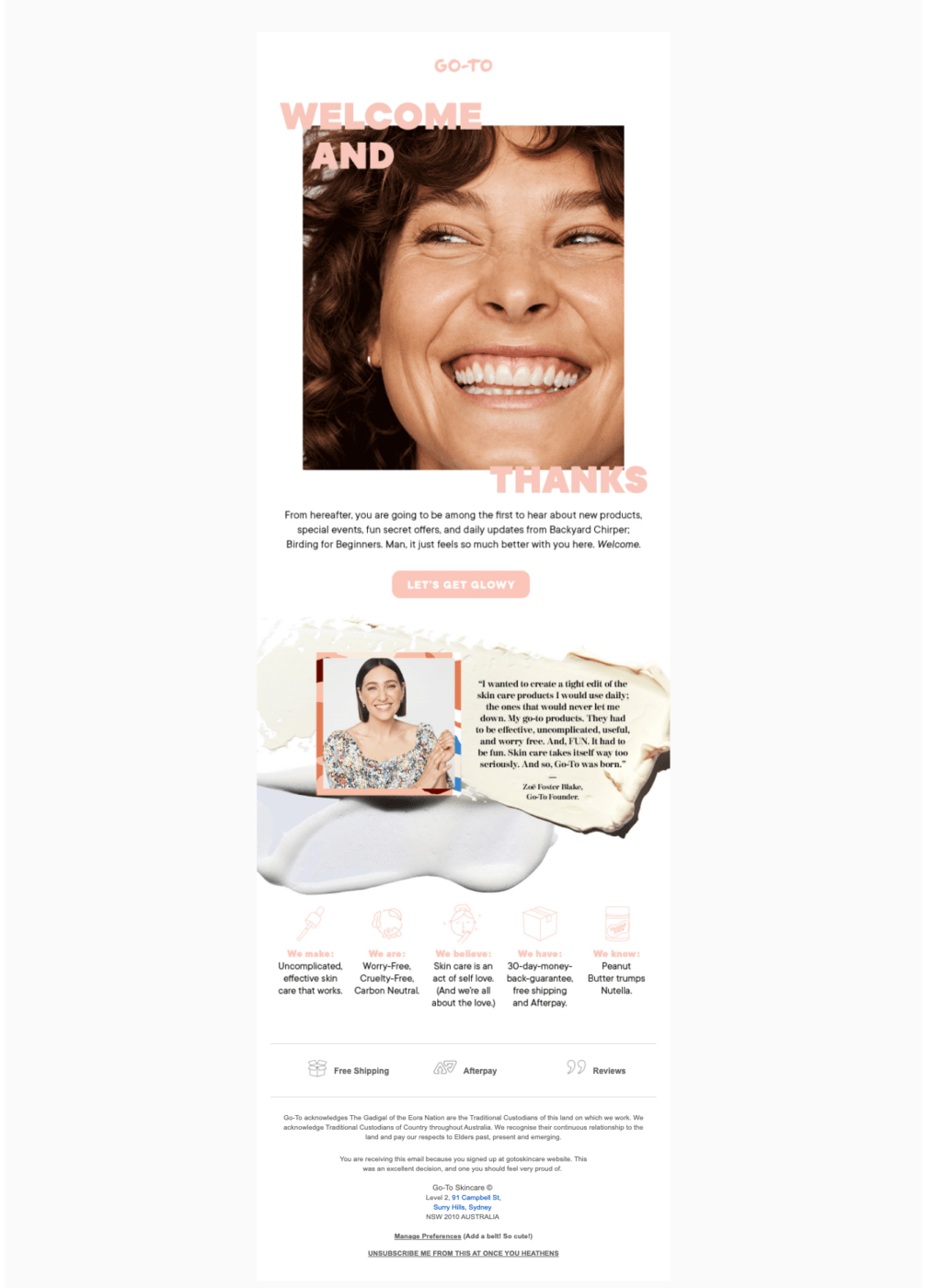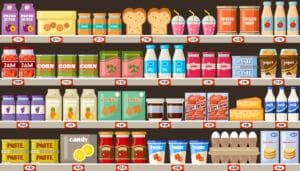Let’s talk about the dreaded blank page. The one where the cursor blinks at you expectantly while you find yourself wondering what to write. That feeling you get when you know you need to create content to support your marketing strategy but inspiration deserts you.
You know what you can do and you know the value your offering provides. You know how to give your customers what they want. So, why is it so difficult to find the words to share that with the world? How do you get people to take notice and even more importantly, take action?
Copywriting is the art of persuading people to do just that. Copywriting isn’t just content or words on the page. It’s about knowing your market, understanding what pains them and using the right words to spark an emotional connection to drive action.
Good copywriting clearly communicates why your target market should care about your product. Using action words, stories, persuasive language and strong calls to action to encourage action.
While there are professional copywriters out there who know all the tricks of the trade, you don’t need to engage a professional to improve your messaging. Luckily, there are formulas, guides and strategies to help reduce the chance of that taunting, blinking cursor derailing your marketing efforts.
Copywriting Basics for Marketing
Just like marketing, to create good content you need good strategy. Yes, I’m big on strategy but it’s crucial and it works! A lot of the answers you’ll need for good copywriting will come from your existing marketing strategy, so if you don’t already have one, it’s time to get strategic.
To write effective content, you’ll need to understand the following:
- Your target market – who are you trying to reach? This will help you nail the right tone and language and hone in on what matters to them most.
- Their pain points – what is their biggest problem? Good copywriting starts by talking about their problem in language they understand before providing a solution.
- Your brand – what is your business identity? Understanding your brand and your values gives you insight into how you can create a consistent message.
- Your offering – what are you selling? You need to be crystal clear on this so you can communicate effectively with your audience and tell them why you’re best.
- Your point of difference – why should someone choose you? This will give you direction when coming up with a content strategy and give you focus.
- Your goal – what are you looking to achieve? This will determine your calls to action and help identify the best content approach to meet your goals.
With this information in place, you’ve got the foundations of a successful content strategy. But how does this work in action? How can this knowledge help you fill that blank page and put the blinking cursor in its place?
Copywriting 101
Having a clear marketing and messaging strategy in place makes it so much easier (and effective!) to connect with your target market. When you have a purpose for your messaging, it’s a whole lot easier to get started.
The second part of the copywriting puzzle is to understand a few common techniques that will take your content from okay to outstanding. And that process starts with AIDA (no, not the opera!) The popular marketing model – Attention. Interest. Desire. Action.
AIDA is the cornerstone of copywriting. It provides an easy-to-follow formula for creating content and leading prospects from visitors to consumers. So, how does it work?
Attention
The idea is to grab attention by using words that resonate with your target market. This starts with a headline and/or subheadline using specific words to get someone to stop scrolling and start reading. If you understand your audience and what pains them, you can create content that speaks directly to them, using language they understand.
As an example, if your target market is busy mums looking for lunchbox ideas, attract attention by directly calling out to them and acknowledging their problem:
Mums – are you falling out of love with making lunches? Check out these easy lunchbox recipe ideas that your kids will LOVE!
In this example, you grab attention in several ways. First, you directly appeal to your market by calling them out. Second, you identify a real pain point. And third, you provide a possible solution to their problem, using powerful words such as “easy” and “love”.
Including other elements into your copy, such as images, videos and gifs also help attract attention and prime your audience to stop scrolling and start reading.
DRIVE REAL RESULTS FOR YOUR BUSINESS
Interest
Once you have their attention, it’s time to engage your audience’s interest. This can be done by expanding on the promise you made in the headline by sharing a story or an anecdote to prove that you truly get them and understand their problem. Going back to the busy mum example, you could share a funny story about a lunch making fiasco to set the tone.
Then maintain interest by sharing examples of how your offering can help, making a clear link between their problem and your product or service. Keep linking back to relevant pain points and how your offering is the answer for them. You might be surprised to learn that in copywriting it’s actually less about what you do and more about how you can help your target audience.
To add further interest, use good quality images, dynamic videos or relatable gifs to break up the text and help reinforce your message. Avoid long sentences and big paragraphs as this can turn off readers and make it hard for them to stick around.
Desire
After you’ve set the groundwork, it’s easy to create a feeling of desire in your audience. This is where you lay out all the benefits of your product or service and explain specifically how they will help potential customers. Anticipate their concerns and provide reassurance through guarantees and warranties so you remove barriers to purchase.
Include examples and testimonials to offer further proof that your solution is the one for them. Use media (videos, photos, gifs, etc.) to provide compelling visual examples of your offering and include a clear call to action to drive customers towards a desired action.
As an example, for busy mums looking for lunchbox recipe ideas, you can create desire by showing them examples of your recipes, combined with gorgeous photography and a how-to video. You can also encourage them to take action with a free recipe resource or by inserting an affiliate link so they can instantly buy an easy clean lunchbox.
Remember to always keep the needs of your audience top of mind. Make it easy for them to see how your product or service could improve their lives and be worth the investment.
Action
Finally, it’s time to encourage action by sharing your offering. Ensure your wording is clear so your customers understand exactly what they are getting and tell them what to do to take action. Don’t try to be too clever or cute. Make it easy for your audience by being crystal clear on what they get and how they can take advantage of your solution.
This where you combine a strong call to action with a sense of urgency to create FOMO. Use phrases like “act now”, “don’t miss out”, “be quick” and “flash sale” to get your audience to act. Stick to one call to action for consistency, lest you confuse your audience by giving them too many options.
Back up your call to action with further social proof to allay fears. Share customer reviews, client testimonials and recommendations. By the way, using the words of your audience in your copy is a powerful way to encourage action and reinforce that you understand their needs and can meet them.
The AIDA model can be used for any type of content and is a handy way to stay on track and ensure you have the best chance of engaging your audience. Here’s how you can use the AIDA model in different content structures.
Copywriting Examples for Marketing
Social media captions
You might think there’s no way you can incorporate the AIDA model in a social media caption but that’s not the case. First off, you’re generally captioning a photo or other visual asset so you’re already attracting attention. The job of the caption is to capture interest, create desire and draw your audience to your preferred action. And here’s how you can do that.
- Use an amazing graphic – these days you need to bring your A game to social media so ensure you choose a photo or video that is visually interesting, matches your brand colours, tells a story and speaks to the pain points of your audience.
- Make your caption relatable – tell a story with your caption to maintain interest. Ensure the post relates to your business, whether it’s a behind the scenes peek, a day in the life glance or a client testimonial. Be conversational, use emojis and be true to your brand.
- Focus on a clear benefit – make it easy for your audience to see how you can help them. Concentrate on their pain points, offer a solution, and show the benefit of using your product or service rather than just spruiking the features of your offering.
- Include a call to action – invite your audience to take action by clicking a link to your shop, signing up to an email list or reading your latest post. Your call to action should be bold, easy to follow and give your audience real value.
The Digital Picnic used the AIDA model in one of their recent posts, featuring a bright image with a real person and a dog (a surefire attention grabber!). In their short caption, they get straight to business in a conversational way, talk immediately about a pain point, reassure the audience they have a solution and provide a clear link for further information. They even include an emoji (bonus points!)

About page
You may be surprised to learn that the about page on your website is one of the most visited on your site. Why? Because potential clients and customers want to get to know you, especially if they’re considering a purchase. Your home page and other landing pages help reel them in but it’s often how you present yourself and your business on your about page that seals the deal.
Now, you might be wondering how does the AIDA model work on a page that is all about you, rather than about your customers? While a standard about page IS about you, it’s also a valuable page on your site where you can make a connection with your audience by sharing your values and telling them WHY you do what you do. Here’s how.
- Introduce yourself – people want to know there is a real person behind the business so show them who you are. Include a good quality photo, share a little bit about yourself and explain why you do what you do. This is a great way to attract attention.
- Include the audience – once you’ve humanised your brand by sharing a piece of who you are, bring it back to the matter at hand – how you can help them. You can maintain interest by stating your brand values, talking about your services or sharing causes.
- Provide proof – set out your experience, show off your awards, add in some testimonials and link to client reviews to encourage desire in your audience. This is not about showing off – this is about creating trust, credibility and authenticity.
- Make it easy to act – add an email subscription form, provide a free download or refer people to your ecommerce store. Once your audience knows who you are, they are more likely to take action. Take advantage of this with a strong and clear call to action.
Kelly Eamens Copywriter has a great about page on her site. She introduces herself straight up, adding in humour together with some great images to grab attention. She wastes no time cultivating interest by putting the focus back on her audience before sharing a little more about herself and her experience to create desire. Kelly also demonstrates her social conscience and her brand values before guiding the audience to a clear call to action – “work with me.”

Email newsletters
Email marketing can be a hard nut to crack as there are an estimated 270 billion emails sent every day! However, following the AIDA method and thinking carefully about your subject lines and headings will increase your open rates and see a rise in conversions.
Start by using power words to get people interested enough to click open. Words like surprising, exciting, special, secret, exclusive, limited, discover, hurry, easy, quick and proven have a particular power in copywriting, so be sure to use these when coming up with your subject line.
NEED SOME GUIDANCE WITH YOUR MARKETING?
Take advantage of our free 15-minute discovery call and discover what your business needs to grow.
Email newsletters work best when they are conversational, include lots of links to resources and give real value to your audience. In the end, you want your email to be welcomed into inboxes (rather than instantly deleted). Here are some ideas to help.
- Nail the subject line – think about your audience when coming up with a subject line. What will interest them? How can you help them? Use power words, numbers, keywords, adjectives and a promise to attract attention in their inbox.
- Keep it brief – no-one has time to read a huge email these days. Add direct links to blog posts or resources instead of including all the details in your newsletter to maintain interest. Help people skim more quickly by using subheadings throughout.
- Ask a question – a newsletter gives you a rare opportunity to have a direct one-on-one discussion with your audience. Invite connection and further engagement by asking a question to get your subscribers to hit reply and keep the conversation going.
- Include multiple links – add several calls to action in your email newsletter to give your audience every opportunity to take action. Add a button CTA towards the top and bottom of your email and directly link using anchor text within your email copy.
Go To Skincare have nailed their copy for their site and email marketing. The subject line reads “Our Dreams Have Come True” which is intriguing and welcoming. The email is not too long and features dynamic images that add interest. There’s a word from Zoe Foster Blake (the founder) that reminds the audience of the powerhouse behind the brand and their core values. The use of humour warms the copy and there’s multiple links to take subscribers back to the website.

Sales emails
Where a newsletter’s job is to build trust, a sales email is all about conversion. Once you’ve warmed up your audience with free resources, information and tips and tricks, you have a much better chance of converting your subscribers and increasing your sales and revenue. However, it’s possible to find success emailing cold prospects too. The key to conversion lies in captivating subject lines and using AIDA to get readers over the line.
For headlines, there is a formula you can follow to get more attention. Start with a number or a trigger word (8, 17, best, how to, boost, etc.). Then add an adjective (unbelievable, successful, amazing, surefire, creative, etc.), a relevant keyword (dresses, lunchboxes, copywriting, etc.) and finally a promise (tips, tricks, ultimate guide, etc.). like these examples:
21 cute lunch boxes that won’t break the bank Number/Trigger = 21 | How to supercharge your consultancy for success Number/Trigger = How to | Best ever kid-friendly recipes they’re sure to scoff down Number/Trigger = Best ever |
To improve open and conversion rates for your sales emails, follow the copywriting tips below:
- Add urgency to the subject line – attract attention with trigger phrases such as “you won’t want to miss”, “be the first to”, and “limited time only”. Use a headline analyser tool to measure the effectiveness of your subject line before hitting send.
- Concentrate on one idea – don’t confuse your readers with lots of reasons why they should buy from you. Keep it clean and simple by focusing on one core product, service or benefit so they are left in no doubt when it comes time to take action.
- Put the reader front and centre – think about their pain points and write TO them not AT them. While you are selling your product and services, you still need to connect them to the needs of your reader, so they know how they benefit when they take action.
- Use action words for your CTA – a helpful tip for writing CTAs is to imagine the sentence starts with “I want to…”. I want to BUY NOW. I want to CALL TODAY. I want to GET STARTED. I want to BOOK NOW. I want to START SHOPPING.
Divi uses a compelling headline in their latest sales email – “The Countdown Is On!!! Our 2020 End of Year Blowout Sales ENDS This Week 

Sales page
Before we dive into sales pages, let’s cover a few basic rules when it comes to website pages and posts. Whether you’re creating a homepage, about page, sales landing page or blog post it helps to understand a few key concepts to boost your SEO and usability.
- Each page and post should contain at least 300 words. The search algorithms prefer pages with a good amount of content and may penalise pages with thin content. That doesn’t mean your content should be a 300-word block of text! Break up content into bullet points, headings, small paragraphs and columns for the best result.
- Think about keywords. Each page and post should have a dedicated primary keyword and a few secondary keywords (synonyms) to help search engines rank the content in relevant results. Don’t use the same primary keyword on different pages – change them up to give your site more chance of ranking for multiple keywords.
- Add keywords into headings and subheadings. In addition to being valuable for SEO, using subheadings in your content breaks up the text and makes it easier for your audience to read. Headings also help your readers to skim through the content and find exactly what they need, quickly and easily.
- Include keywords in page metadata. Your keywords should also be included in image titles, page title tags and in meta descriptions. In WordPress this can be done with the Yoast SEO Plugin. Including keywords in page metadata sends strong signals to Google and helps your page/post rank higher for relevant keywords.
Back to sales pages. Generally, sales pages are a lot longer than 300 words for a reason – this is full-on AIDA in action. Your sales landing page needs to be compelling (with a strong headline), visually appealing (with lots of images, logos and even video), persuasive (with testimonials and reviews) and well-structured to help visitors take action (with the use of regular CTAs across the page).
- Start with an introduction – set the scene by talking about the problem your audience faces and how it impacts their lives. Remind them of how painful it is to deal with, using emotive language to get an immediate response.
- Be clear on HOW your solution helps – use examples, reviews and testimonials to prove its worth. Use numbers and statistics to state your case and use graphics to break up the text and reinforce your message. There’s never too much info on a sales page!
- Anticipate barriers to purchase – think of every barrier to purchase and have a ready answer to address them. Take a deep dive into each element of your solution to ensure that you answer every possible question so there’s no reason NOT to take action.
- Provide lots of value – price out every element of your offer so your audience truly understands the value they will get. Add bonuses to add more value and don’t forget to remind them of the non-monetary benefits they will also receive by choosing you.
The Recipe for SEO Success sales page features all the elements of a successful sales page. It has an eye-catching header, strong introduction, videos, graphics, testimonials, reviews, a deep dive into the course, FAQs, statistics, bonus offers, lots of value adds and conversational copy that speaks directly to the needs and pain points of the audience. You won’t read everything on the page but there’s so much there that you’ll feel reassured anyway!

Blog posts
Writing blog posts can seem daunting but it really doesn’t have to be. If you’re struggling to come up with ideas for posts, look at your website structure and identify the main topics you cover (your categories). Identify 5 categories and think about the 4 most common questions you get in each one. There’s the basis for 20 blog posts right there – not that hard, huh?
This is also the start of a blog content plan. If you plan out your content before you sit down to write anything, you’ll never be stuck for ideas again. You’ll be able to deliver more consistent content that actually meets the needs of your audience (because your posts are answering their questions). This will result in more engaging posts and more views and shares.
Every post should begin with an introductory paragraph to explain the topic and why your readers should care about it and end with a conclusion that ties up the post and ends with a call to action (CTA). It’s good practice to link between relevant posts and pages to boost SEO using anchor text (hyperlink within content – like this). Using images and video breaks up your text and add interest while subheadings help improve readability and SEO.
When it comes to blog post structure, there are a few formats that make writing posts a lot easier:
- List posts are the easiest and involve simple bullet points talking about “5 reason to…”, “3 top places…”, “7 ways you can…”, etc. Start with a quick introduction paragraph to explain the purpose of the post and end with a concluding paragraph and a call to action.
- Question posts start with a question and provide a solution to a problem. Think “How can…?”, “What is involved in…?”, “Why should you…?”, “When to consider…?”, “Who to call when…?”, etc. These posts are perfect for answering FAQs and building SEO.
- Comparison posts compare different things to help readers make a decision. Examples include “QuickBooks v Xero? 5 key differences”, “Should you buy a house or keep renting?” and “How to choose between cloud security applications.”
- How-to posts explore how to do something, and they are among the most powerful of all blog post formats. You can create how-to posts for just about anything involving your products or services. Get inspiration from Google search if you’re lost for ideas.
- Case study posts analyse your clients or customers and share their story of success using your solution. These are especially useful in the B2B space (giving each business a shout out) but don’t forget the power of user generated content in the B2C context.
- Deep dive posts are longer posts and a winner for SEO. These are over 1500 words long and take a deeper look into a core offering, industry trends, current events, or other more detailed topics. These are perfect for building authority in your industry.
A great example of a B2C blog post is Vinomofo. In this post, they’ve combined the question and list post formulas to create a tongue-in-cheek article that is fun yet informative and totally on brand. They start with a bit of an introduction then they get into the list, separating each point with a high-quality photo. Anchor text is used to link to their wines in each example and they’ve included a call to action at the end to shop the range.

Marketing Sense is here to guide your small business toward marketing success using the power of content marketing. Give us a call to discuss your needs and download your FREE copy of our Brand Statement Worksheet to get crystal clear on your business, your offering, your audience, and your competition.
Grow your business





